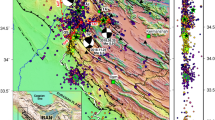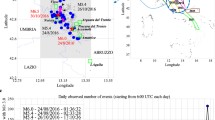Abstract
The stationary Epidemic-Type Aftershock Sequence (ETAS) model is applied to seismicity in Central Italy, in order to study the temporal changes of the corresponding earthquakes time series. However, the residual analysis reveals that some features of the observed seismicity cannot be captured by the stationary ETAS model in its standard formulation. In this case, a decision-tree algorithm is developed to deal with inference problems linked to the estimation of specific time points where stationarity may be potentially broken. Specifically, this algorithm considers the subdivision of the whole time period into two or more subintervals that join in specific time points called change points, where significant time variation in the ETAS parameters is observed. As a result, a three-stage ETAS model with two change points is selected as the best model describing seismicity of the Central Apennines region during the time period 2005–2017, compared to the standard ETAS model. The variation of the estimated ETAS parameters is statistically significant from one stage to another. In particular, the three-stage ETAS estimates of background seismicity rates are found to be increasing from one stage to another over time.













Similar content being viewed by others
References
Bansal AR, Ogata Y (2013) A non–stationary epidemic type aftershock sequence model for seismicity prior to the December 26, 2004 M9.1 Sumatra-Andaman Islands mega–earthquake. J Geophys Res 118:616–629. https://doi.org/10.1002/jgrb.50068
Bansal AR, Dimri VP, Babu KK (2012) Epidemic type aftershock sequence (ETAS) modeling of northeastern Himalayan seismicity. J Seismol 17:255–264. https://doi.org/10.1007/s10950-012-9314-7
Benali A, Peresan A, Varini E, Talbi A (2020) Modelling background seismicity components identified by nearest neighbour and stochastic declustering approaches: the case of Northeastern Italy. Stoch Environ Res Risk Assess 34:775–791. https://doi.org/10.1007/s00477-020-01798-w
Chiarabba C, De Gori P, Cattaneo M, Spallarossa D, Segou M (2018) Faults geometry and the role of fluids in the 2016–2017 Central Italy seismic sequence. Geophys Res Lett 45:6963–6971. https://doi.org/10.1029/2018GL077485
Gentili S, Di Giovambattista R, Peresan A (2017) Seismic quiescence preceding the 2016 central Italy earthquakes. Phys Earth Planet Inter 272:27–33. https://doi.org/10.1016/j.pepi.2017.09.004
Gulia L, Wiemer S (2019) Real-time discrimination of earthquake foreshocks and aftershocks. Nature 574(7777):193–199. https://doi.org/10.1038/s41586-019-1606-4
Gulia L, Tormann T, Wiemer S, Herrmann M, Seif S (2016) Short-term probabilistic earthquake risk assessment considering time-dependent b values. Geophys Res Lett 43:1100–1108. https://doi.org/10.1002/2015GL066686
Guo Y, Zhuang J, Zhou S (2015a) A hypocentral version of the space–time ETAS model. Geophys J Int 203(1):366–372. https://doi.org/10.1093/gji/ggv319
Guo Y, Zhuang J, Zhou S (2015b) An improved space–time ETAS model for inverting the rupture geometry from seismicity triggering. J Geophys Res Solid Earth 120(5):3309–3323. https://doi.org/10.1002/2015JB011979
Guo Y, Zhuang J, Hirata N, Zhou S (2017) Heterogeneity of direct aftershock productivity of the main shock rupture. J Geophys Res Solid Earth 122:5288–5305. https://doi.org/10.1002/2017JB014064
Guo Y, Zhuang J, Hirata N (2018) Modelling and forecasting 3d–hypocentre seismicity in the kanto region. Geophys J Int 214(1):520–530. https://doi.org/10.1093/gji/ggy154
Gutenberg B, Richter CF (1944) Frequency of earthquakes in California. Bull Seismol Soc Am 34:185–188
Hainzl S, Ogata Y (2005) Detecting fluid signals in seismicity data through statistical earthquake modeling. J Geophys Res 110:B05S07. https://doi.org/10.1029/2004JB003247
Hainzl S, Zakharova O, Marsan D (2013) Impact of aseismic transients on the estimation of aftershock productivity parameters. Bull Seismol Soc Am 103(3):1723–1732. https://doi.org/10.1785/0120120247
Hawkes AG (1971) Spectra of some self–exciting and mutually exciting point processes. Biometrika 58:83–90
Hawkes AG, Oakes D (1974) A cluster process representation of a self–exciting process. J Appl Probab 11:493–503
Kisslinger C, Jones ML (1991) Properties of aftershocks in southern California. J Geophys Res 96:11947–11958
Kumazawa T, Ogata Y (2013) Quantitative description of induced seismic activity before and after the 2011 Tohoku-Oki earthquake by nonstationary ETAS models. J Geophys Res Solid Earth 118:6165–6182. https://doi.org/10.1002/2013JB010259
Kumazawa T, Ogata Y (2014) Nonstationary ETAS models for nonstandard earthquakes. Ann Appl Stat 8:1825–1852. https://doi.org/10.1214/14-AOAS759
Kumazawa T, Ogata Y, Tsuruoka H (2019) Characteristics of seismic activity before and after the 2018 M6.7 Hokkaido Eastern Iburi earthquake. Earth Planets Space 71(130):1–17. https://doi.org/10.1186/s40623-019-1102-y
Lewis F, Butler A, Gilbert L (2011) A unified approach to model selection using the likelihood ratio test. Methods Ecol Evol 2:155–162. https://doi.org/10.1111/j.2041-210X.2010.00063.x
Liu Y, Zhuang J, Jiang C (2021) Background seismicity before and after the 1976 Ms 7.8 Tangshan earthquake: is its aftershock sequence still continuing? Seismol Res Lett 92:877–885. https://doi.org/10.1785/0220200179
Llenos AL, McGuire JJ, Ogata Y (2009) Modeling seismic swarms triggered by aseismic transient. Earth Planet Sci Lett 281:59–69
Lombardi AM (2017) The epistemic and aleatory uncertainties of the ETAS–type models: an application to the Central Italy seismicity. Nat Sci Rep 7(11812):1–9. https://doi.org/10.1038/s41598017-11925-3
Lombardi AM, Marzocchi W (2007) Evidence of clustering and nonstationarity in the time distribution of large worldwide earthquakes. J Geophys Res 112:B02303. https://doi.org/10.1029/2006JB004568
Lombardi AM, Marzocchi W, Selva J (2006) Exploring the evolution of a volcanic seismic swarm: the case of the 2000 Izu Islands swarm. Geophys Res Lett 33:L07310. https://doi.org/10.1029/2005GL025157
Lombardi AM, Cocco M, Marzocchi W (2010) On the increase of background seismicity rate during the 1997–1998 Umbria–Marche, Central Italy, sequence: apparent variation or fluid driven triggering? Bull Seism Soc Am 100(3):1138–1152. https://doi.org/10.1785/0120090077
Mancini S, Segou M, Werner MJ, Cattania C (2019) Improving physics-based aftershock forecasts during the 2016–2017 Central Italy Earthquake Cascade. J Geophys Res Solid Earth 124:8626–8643. https://doi.org/10.1029/2019JB017874
Martinelli G, Facca G, Genzano N, Gherardi F, Lisi M, Pierotti L, Tramutoli V (2020) Earthquake-related signals in Central Italy detected by hydrogeochemical and satellite techniques. Front Earth Sci 8:584716. https://doi.org/10.3389/feart.2020.584716
Marzocchi W, Lombardi AM (2008) A double branching model for earthquake occurrence. J Geophys Res 113:B08317. https://doi.org/10.1029/2007JB005472
Mogi K (1962) On the time distribution of aftershocks accompanying the recent major earthquakes in and near Japan. Bull Earthq Res Inst 40:175–185
Mogi K (1967) Earthquakes and fractures. Tectonophysics 5:35–55
Ogata Y (1988) Statistical models for earthquake occurrences and residual analysis for point process. J Am Stat Assoc 83(401):9–27
Ogata Y (1992) Detection of precursory seismic quiescence before major earthquakes through a statistical model. J Geophys Res 97:19845–19871
Ogata Y (1998) Space–time point–process models for earthquake occurrences. Ann Inst Stat Math 50:379–402
Ogata Y (1999) Seismicity analysis through point–process modeling: a review. Pure Appl Geophys 155:471–507. https://doi.org/10.1007/s000240050275
Ogata Y (2005) Detection of anomalous seismicity as a stress change sensor. J Geophys Res B05S06:100. https://doi.org/10.1029/2004JB003245
Ogata Y (2006a) Seismicity anomaly scenario prior to the major recurrent earthquakes off the East coast of Miyagi prefecture, northern Japan. Tectonophysics 424:291–306. https://doi.org/10.1016/j.tecto.2006.03.038
Ogata Y (2006b) Statistical Analysis of Seismicity–updated version (SASeis2006b), Computer Science Monographs, 33, The Institute of Statistical Mathematics, Tokyo, Japan. http://www.ism.ac.jp/editsec/csm/index_j.html
Peresan A, Gentili S (2020) Identification and characterization of earthquake clusters: a comparative analysis for selected sequences in Italy and adjacent regions. Boll Geofis Teorica Appl 61(1):57–80. https://doi.org/10.4430/bgta0249
Plaza F, Salas R, Nicolis O (2019) Assessing seismic hazard in Chile using deep neural networks. INTECH. https://doi.org/10.5772/intechopen.83403
Schoenberg FP (2002) On rescaled poisson processes and the Brownian bridge. Ann Inst Stat Math 54:445–457
Talbi A, Yamazaki F (2010) A mixed model for earthquake inter–event times. J Seismol 14:289–307. https://doi.org/10.1007/s10950-009-9166-y
Talbi A, Kazuyoshi N, Satake K, Zhuang J, Hamdache M (2013) Comparison of seismicity declustering methods using a probabilistic measure of clustering. J Seismol 17:1041–1061. https://doi.org/10.1007/s10950-013-9371-6
Taroni M, Vocalelli G, De Polis A (2021) Gutenberg-Richter B-value time series forecasting: a weighted likelihood approach. Forecasting 3:561–569. https://doi.org/10.3390/forecast3030035
Teng G, Baker JW (2019) Seismicity declustering and hazard analysis of the Oklahoma-Kansas Region. Bull Seismol Soc Am 109(6):2356–2366. https://doi.org/10.1785/0120190111
Touati S, Naylor M, Main IG, Christie M (2011) Masking of earthquake triggering behavior by a high background rate and implications for epidemic–type aftershock sequence inversions. J Geophys Res 116(B03304):1–16. https://doi.org/10.1029/2010JB007544
Varini E, Peresan A, Zhuang J (2020) Topological comparison between the stochastic and the nearest-neighbour earthquake declustering methods through network analysis. J Geophys Res Solid Earth 125:1–46. https://doi.org/10.1029/2020jb019718
Vere-Jones D (1970) Stochastic models for earthquake occurrence (with discussion). J R Stat Soc B32:1–62
Walters RJ, Gregory LC, Wedmore LNJ, Craig TJ, McCaffrey K, Wilkinson M, Chen J, Li Z, Elliott JR, Iezzi H, Livio F, Michetti AM, Roberts GP, Vittori E (2018) Dual control of fault interactions on stop-start rupture in the 2016 Central Italy seismic sequence. Earth Planet Sci Lett 500:1–14. https://doi.org/10.1016/j.epsl.2018.07.043
Xu G, Xu C, Wen Y, Jiang G (2017) Source Parameters of the 2016–2017 central Italy earthquake sequence from the Sentinel-1, ALOS-2 and GPS data. Remote Sens 9(11):1182. https://doi.org/10.3390/rs9111182
Zaliapin I, Ben-Zion Y (2020) Earthquake declustering using the nearest-neighbor approach in space-time-magnitude domain. J Geophys Res Solid Earth 125:e2018JB017120. https://doi.org/10.1029/2018JB017120
Zhang L, Huang D, Jiang Z, Feng W, Hassan A (2021) Seismic stress perturbation and triggering patterns induced by the 2016 Central Italy earthquake sequences. J Mt Sci 18:1424–1438. https://doi.org/10.1007/s11629-020-6527-z
Zhuang J (2000) Statistical modelling of the seismicity patterns before and after the 1990 Oct 5 Cape Palliser earthquake, New Zealand. N Z J Geol Geophys 43:447–460. https://doi.org/10.1080/00288306.2000.9514901
Zhuang J, Ogata Y (2006) Properties of the probability distribution associated with the largest earthquake in a cluster and their implications to foreshocks. Phys Rev E 73(046134):1–12. https://doi.org/10.1103/PhysRevE.73.046134
Zhuang J, Ogata Y, Vere-Jones D (2002) Stochastic declustering of space–time earthquake occurrences. J Am Stat Assoc 97:369–380. https://doi.org/10.1198/016214502760046925
Zhuang J, Ogata Y, Wang T (2017) Data completeness of the Kumamoto earthquake sequence in the JMA catalog and its influence on the estimation of the ETAS parameters. Earth Planets Space 69(36):1–12. https://doi.org/10.1186/s40623-017-0614-6
Zhuang J, Murru M, Falcone G, Guo Y (2019) An extensive study of clustering features of seismicity in Italy from 2005 to 2016. Geophys J Int 216(1):302–318. https://doi.org/10.1093/gji/ggy428
Zhuang J, Werner MJ, Hainzl S, Harte D, Zhou S (2011) Basic models of seismicity: spatiotemporal models. Community Online Resource for Statistical Seismicity Analysis, 1–20. https://doi.org/10.5078/corssa-07487583. http://www.corssa.org
Zhuang J, Harte D, Werner MJ, Hainzl, Zhou S (2012) Basic models of seismicity: temporal models, Community Online Resource for Statistical Seismicity Analysis, 1–42, doi:https://doi.org/10.5078/corssa-79905851. http://www.corssa.org
Acknowledgements
Many thanks are due to the Institute of Statistical Mathematics (ISM) in Tokyo, Japan, for providing the codes destinated to the estimation of the ETAS parameters, freely available via the link https://www.ism.ac.jp/~ogata/Ssg/ssg_softwaresE.html. The financial support from Research Organization of Information and Systems (ROIS) is kindly acknowledged, because of its full coverage of the expenditures of the first author visit to ISM. This research benefitted also from the support of the Centre de Recherche en Astronomie, Astrophysique et Géophysique (CRAAG) in Algiers, Algeria. The authors thank two anonymous reviewers for their constructive comments that significantly improved this article.
Author information
Authors and Affiliations
Corresponding author
Ethics declarations
Conflict of interest
The authors declare that there is no conflict of interest.
Additional information
Edited by Prof. Ramón Zúñiga (CO-EDITOR-IN-CHIEF).
Rights and permissions
About this article
Cite this article
Benali, A., Zhuang, J. & Talbi, A. An updated version of the ETAS model based on multiple change points detection. Acta Geophys. 70, 2013–2031 (2022). https://doi.org/10.1007/s11600-022-00863-y
Received:
Accepted:
Published:
Issue Date:
DOI: https://doi.org/10.1007/s11600-022-00863-y




